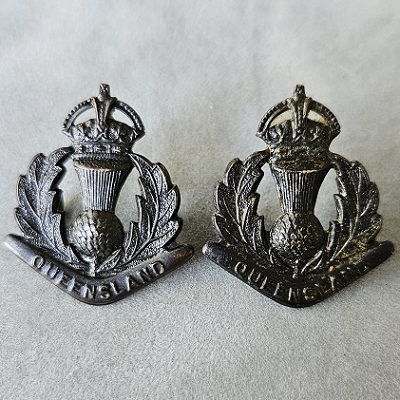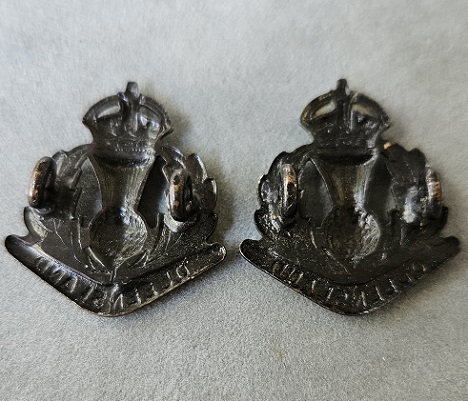Description
Description: 61st Battalion (Cameron Highlanders of Queensland) – Oxidised Collar Badge Pair – 1930 to 1942
Maker’s Name: Unknown
Condition: Near Mint Plus
Comments: 61st Battalion (Cameron Highlanders of Queensland) – Oxidised Collar Badge Pair – 1930 to 1942. Complete with 2 lugs.
Oxidised badges were only worn after the commencement of the Second World War and are thus more scarcer than brass badges.
After the First World War the defence of the Australian mainland lay with the part-time soldiers of the Citizens Military Force (CMF), also known as the Militia. The Militia was organized to maintain the structure of the First AIF and kept the same numerical designations. The Militia units were distributed in the same areas the original AIF units were raised.
In 1937 with tensions growing in Europe, it was decided to raise a new infantry battalion in the Brisbane-Ipswich area. The local Scottish community, who wanted Queensland to have its own Scottish regiment, lobbied for the newly raised 61st Infantry Battalion to be linked with a Highland regiment. In 1939 the 61st was linked with the Queen’s Own Cameron Highlanders and became the “Queensland Cameron Highlanders”.
After the declaration of the Second World War the battalion frequently held training camps at Redbank and Chermside lasting 70 to 90 days. During 1940 the 61st Battalion was called-up and the battalion joined the rest of the 7th Brigade (comprising the 9th/49th and 15th Battalions) at Chermside, a northern suburb of Brisbane. Full-time duty was introduced on 22 September 1941 and the following month the brigade was brought up to strength. The 9th/49th was separated into its two respective units, with the 49th sent to Port Moresby and the 15th later transferred to the 29th Brigade.
The 7th Brigade spent 1941 training at Chermside. When Japan entered the war on 7 December 1941 the 7th Brigade prepared defensive positions at Caloundra.
In May 1942 the 7th Brigade moved to Rollingston, north of Townsville, to defend the area against a possible Japanese landing. In July and August the brigade moved to Milne Bay, at the south-east tip of New Guinea. It took almost a month for the 61st to be transported to Milne Bay, with the first contingent arriving on 15 July and the last on 8 August. The 61st was deployed with the 25th Infantry Battalion to defend the No. 3 strip at Gili Gili.
The Japanese made an amphibious landing at Milne Bay on 27 August. The 61st was first into action but were unable to hold back the Japanese. The Japanese reached the edge of the airstrip the next day, where they waited to be reinforced. In the early-morning of 31 August the Japanese charged the defences manned by the 61st and 25th. The Japanese suffered heavily and withdrew at dawn. By 7 September the battle was over.
The 7th Brigade remained at Milne Bay until March 1943, when it was transferred to Donadabu, near Port Moresby, for training. In November the brigade was progressively returned to Australia, where it was given some leave. In February 1945 it regrouped in the Atherton Tablelands. In July the brigade returned to New Guinea, garrisoning the Madang area before being transferred to Torokina in Bougainville in November. About one-third of the men in the brigade were veterans of Milne Bay.
On Bougainville the 61st served in Southern Sectors. From January to March the 61st joined the brigade’s advance to the Puriata River. Leaving from Jaba River, the 61st moved inland, through Mosina, Sisirua, and Mosigetta until it reached the Puriata. During this time there where morale problems within the battalion but when the Japanese counter-attacked during the battle of Slater’s Knoll, from 29 March to 5 April, the battalion performed well and contributed to the defeat of the Japanese. The 7th Brigade was relieved by the 29th Brigade on 15 April. The 61st took no further part in the campaign, although members of the battalion were involved in the surrender ceremony in Torokina. The battalion was disbanded on 2 February 1946.






